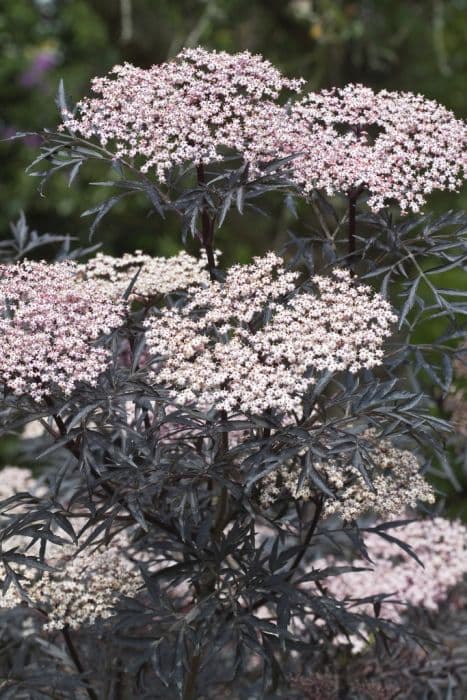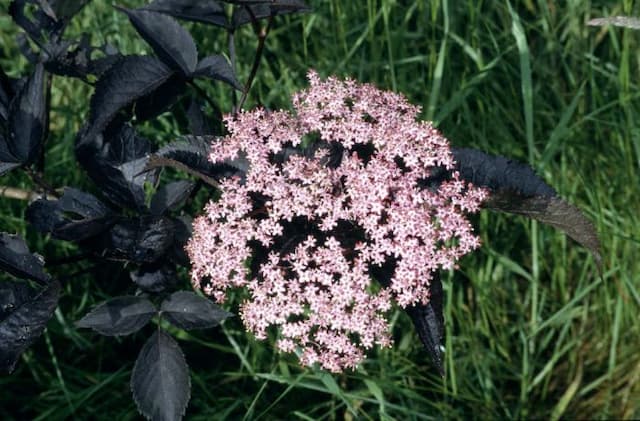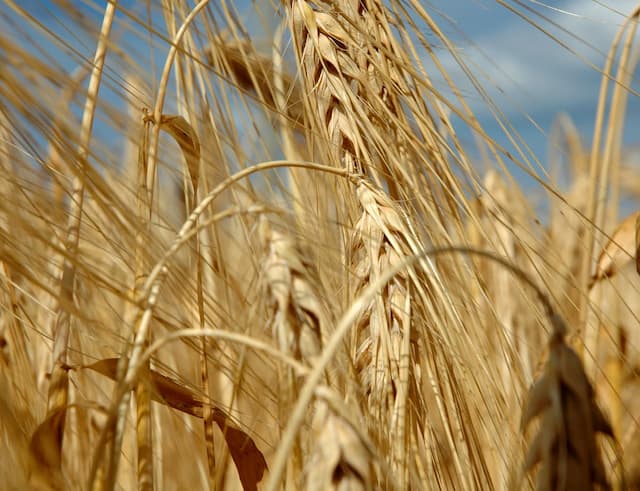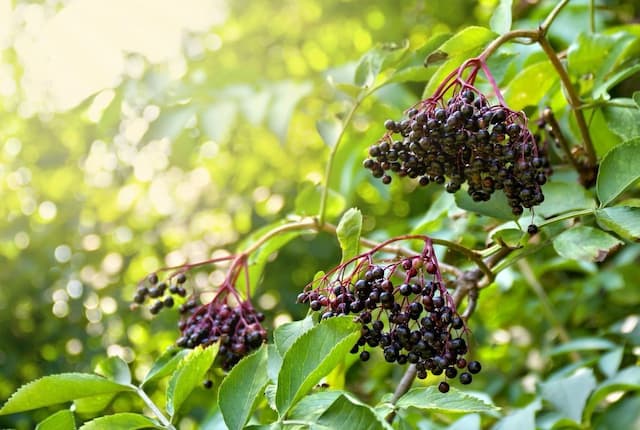Yellow-fruited European cranberry bush Viburnum opulus 'Xanthocarpum'

ABOUT
The plant in question, commonly known as the yellow-fruited guelder rose, is a striking ornamental shrub that catches the eye. It is adorned with three-lobed, maple-like leaves that offer a lush green backdrop in spring and summer, transitioning to a vibrant red color in the fall, creating a seasonal display of visual warmth. The foliage arrangement provides a dense, layered appearance, which adds to its horticultural appeal. In contrast to the usual red berries of its species, this cultivar is distinguished by its striking, translucent yellow fruit that dangle in eye-catching clusters. These clusters of jewel-like berries persist through much of the winter, offering a cheerful note in the stark landscape, and providing food for birds and wildlife. Mid to late spring sees the yellow-fruited guelder rose adorning itself with flowers that are attention-grabbing in their own right. The blossoms are arranged in large, flat-topped clusters known as cymes. The outer ring of the cluster consists of larger, sterile flowers, whose primary function is to attract pollinators, while the smaller, fertile flowers occupying the center are more inconspicuous. These creamy-white blossoms pave the way for the ornamental fruit that follows. The bark and branches have a typical appearance, providing a sturdy structure for the plant and further enhancing its visual interest during the barren winter months when the leaves have fallen. The overall impression of the yellow-fruited guelder rose is one of robust beauty, with seasonally changing colors and features that offer gardeners and nature enthusiasts alike a dynamic and attractive addition to landscapes.
About this plant
 Names
NamesFamily
Adoxaceae
Synonyms
Yellow-fruited European Cranberry Bush, Golden Guelder Rose
Common names
Viburnum opulus var. xanthocarpum, Viburnum opulus f. xanthocarpum
 Toxicity
ToxicityTo humans
The most common common name for Viburnum opulus 'Xanthocarpum' is Guelder Rose. While the ripe berries may be edible when cooked and are used in some traditional recipes, the rest of the plant, particularly the leaves and unripe berries, is considered toxic to humans. Ingesting any parts of the Guelder Rose that are toxic can lead to symptoms like vomiting, diarrhea, convulsions, and sedation. Severe poisoning could potentially result in respiratory failure and cardiac arrest.
To pets
Similar to humans, Guelder Rose is toxic to pets as well. If pets consume parts of this plant, particularly the leaves or unripe berries, they could exhibit symptoms such as vomiting, diarrhea, weakness, and lethargy. In severe cases, ingestion could lead to convulsions, coma, or even death. It is imperative to prevent pets from consuming any part of the Guelder Rose and to seek veterinary assistance immediately if ingestion is suspected.
 Characteristics
CharacteristicsLife cycle
Perennials
Foliage type
Deciduous
Color of leaves
Green
Flower color
White
Height
10-12 feet (3-3.7 meters)
Spread
10-15 feet (3-4.5 meters)
Plant type
Shrub
Hardiness zones
3-8
Native area
Europe
Benefits
 General Benefits
General Benefits- Aesthetic Appeal: Adds visual interest to gardens with its bright yellow berries and attractive white flowers.
- Wildlife Attraction: Berries provide food for birds, while flowers attract pollinators like bees and butterflies.
- Seasonal Interest: Offers year-round interest with flowers in spring, berries in summer and fall, and sometimes reddish leaves in autumn.
- Screening: Dense growth habit makes it suitable for use as a hedge or privacy screen.
- Ease of Care: Generally low-maintenance and tolerates a range of soil types.
- Versatility: Can be planted as a specimen plant, in mixed borders, or used in mass plantings.
- Hardiness: Resistant to cold temperatures, making it suitable for cooler climates.
- Non-Invasive: Unlike some Viburnums, it's not known for being invasive and is generally well-behaved in the landscape.
 Medical Properties
Medical Properties- Antispasmodic: May help relieve muscle cramps and spasms.
- Diuretic: Could increase the production of urine, helping in the management of fluid retention.
- Sedative: Possibly has a calming effect on the nervous system.
- Astringent: Can be used as a topical agent to tighten tissues and reduce discharge or bleeding.
 Air-purifying Qualities
Air-purifying QualitiesThis plant is not specifically known for air purifying qualities.
 Other Uses
Other Uses- Viburnum opulus 'Xanthocarpum', commonly known as guelder rose, can be used as a natural insect repellent when its leaves are crushed and applied to the skin.
- The brightly colored berries serve as a natural dye for fabrics, providing hues ranging from pink to purple depending on the mordant used.
- Guelder rose branches are sometimes used in basket weaving due to their flexibility and strength when properly prepared.
- The dense foliage of the guelder rose can provide protective cover for small wildlife, such as birds and beneficial insects, creating a miniature sanctuary in the garden.
- When dried, the guelder rose's flowers can be used in potpourri mixtures to add a pleasant aroma and decorative touch to a room.
- The hard wood of the guelder rose has been used historically to craft small items like toothpicks and skewers, taking advantage of its fine grain and durability.
- With its dense shape, the guelder rose can be pruned into formal hedges or topiary forms, making it a versatile plant for landscape design.
- Culinary enthusiasts sometimes use the tart berries in small quantities to make jellies or jams, often mixed with other fruits to balance their bitterness.
- The guelder rose's autumn leaves, which turn vibrant shades of red and orange, are used in floral arrangements as a symbol of the changing seasons.
- During festive seasons, guelder rose branches laden with red berries are used as natural, decorative elements for wreaths and centerpieces.
Interesting Facts
 Feng Shui
Feng ShuiThe Guelder Rose is not used in Feng Shui practice.
 Zodiac Sign Compitability
Zodiac Sign CompitabilityThe Guelder Rose is not used in astrology practice.
 Plant Symbolism
Plant Symbolism- Protection: The Viburnum opulus, commonly known as Guelder Rose, has traditionally been used to ward off negative influences and is often planted around homes for protective symbolism.
- Unity: The dense, rounded clusters of flowers symbolize unity and togetherness, reflecting the plant’s appearance as a collection of individuals forming a cohesive whole.
- Abundance: Its prolific red berries can symbolize abundance and prosperity, making it an emblem of generosity and plenty.
- Renewal: Since Guelder Rose is a deciduous shrub that blooms every year, it represents the renewal and the cycle of life.
 Water
WaterGuelder rose, commonly known as Viburnum opulus 'Xanthocarpum', should be watered deeply and thoroughly to encourage root development. During the growing season, it's important to maintain a consistent moisture level in the soil, usually watering once a week with about 1 to 1.5 gallons of water, depending on rainfall and soil type. During hot and dry periods, the frequency may need to increase to twice a week. In winter, reduce watering but don't let the soil completely dry out. Ensure that the soil is well-draining to prevent root rot.
 Light
LightGuelder rose thrives best in full sun to partial shade. The ideal spot for planting would be a location that receives at least 4 to 6 hours of sunlight daily, but is also protected from the hot afternoon sun. Dappled shade is suitable, especially in regions with very intense sunlight, to prevent leaf scorch.
 Temperature
TemperatureGuelder rose is hardy and can tolerate a range of temperatures. It typically can survive minimum winter temperatures down to -30 degrees Fahrenheit and up to 90 degrees Fahrenheit in summer without issue. The ideal growing temperatures range from 60 to 75 degrees Fahrenheit where the plant can grow most vigorously.
 Pruning
PruningPruning Guelder rose is necessary to maintain its shape, remove dead or diseased wood, and encourage blooming. The best time to prune is late winter or early spring before new growth begins. Thin out old and overcrowded branches and trim back branches that spoil the plant's shape. Annual pruning, with additional minor shape adjustments as needed, is generally sufficient.
 Cleaning
CleaningAs needed
 Soil
SoilThe best soil mix for the Guelder Rose is well-draining, loamy soil rich in organic matter with a pH of 5.5 to 6.5. A mix of garden soil, compost, and peat can achieve the right texture and fertility.
 Repotting
RepottingGuelder Rose plants generally do not need frequent repotting; it is typically done every 3-5 years, provided they are planted in the ground and have sufficient space to grow.
 Humidity & Misting
Humidity & MistingGuelder Rose thrives best in average humidity conditions. It is adaptable and does not require a specific humidity level to grow well.
 Suitable locations
Suitable locationsIndoor
For Guelder Rose, provide bright indirect light and adequate space.
Outdoor
Plant in well-draining soil, full sun to partial shade.
Hardiness zone
3-7 USDA
 Life cycle
Life cycleCommonly known as the Yellow-fruiting Guelder Rose, Viburnum opulus 'Xanthocarpum' begins its life cycle as a seed, which after stratification (a cold period), germinates in the spring. The seedling grows into a young plant, establishing a root system and foliage, and can take several years to mature fully. Once mature, this deciduous shrub flowers in late spring, displaying clusters of white flowers that are pollinated by insects. Following pollination, flowers develop into distinctive yellow berries by late summer to fall, which are popular with birds and wildlife. The plant then enters a period of dormancy in winter, where it loses its leaves and conserves energy. The cycle resumes the following spring when new buds swell and open, starting the process anew with growth and eventual flowering.
 Propogation
PropogationPropogation time
Spring-Early Summer
The European Snowball bush, scientifically known as Viburnum opulus 'Xanthocarpum', is commonly propagated by softwood cuttings. For best results, this process is usually carried out in late spring or early summer. To propagate, select a healthy, non-flowering shoot, and cut a piece around 4-6 inches (10-15 cm) long, making sure it has several leaf nodes. Remove the leaves from the lower half of the cutting, and dip the cut end into a rooting hormone for enhanced root development. Then, insert the cutting into a pot filled with a mixture of peat and perlite to retain moisture and support root growth. Keep the cutting in a warm, well-lit area, avoiding direct sunlight, and ensure the soil remains moist but not soggy. Roots typically develop within a few weeks, after which the new plants can eventually be transferred to a suitable location in the garden.









